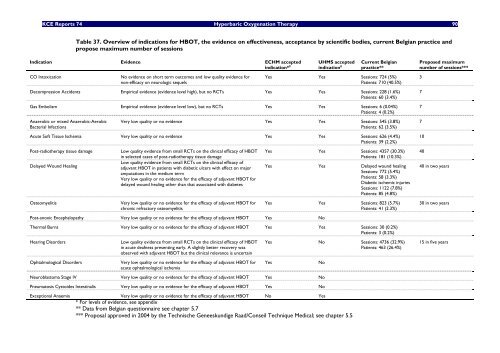Hyperbare Zuurstoftherapie: Rapid Assessment - KCE
Hyperbare Zuurstoftherapie: Rapid Assessment - KCE
Hyperbare Zuurstoftherapie: Rapid Assessment - KCE
You also want an ePaper? Increase the reach of your titles
YUMPU automatically turns print PDFs into web optimized ePapers that Google loves.
<strong>KCE</strong> Reports 74 Hyperbaric Oxygenation Therapy 90<br />
Table 37. Overview of indications for HBOT, the evidence on effectiveness, acceptance by scientific bodies, current Belgian practice and<br />
propose maximum number of sessions<br />
Indication Evidence ECHM accepted<br />
indication* 9<br />
CO Intoxication No evidence on short term outcomes and low quality evidence for<br />
non-efficacy on neurologic sequels<br />
UHMS accepted<br />
indication 8<br />
Current Belgian<br />
practice**<br />
Yes Yes Sessions: 724 (5%)<br />
Patients: 710 (40.5%)<br />
Decompression Accidents Empirical evidence (evidence level high), but no RCTs Yes Yes Sessions: 228 (1.6%)<br />
Patients: 60 (3.4%)<br />
Gas Embolism Empirical evidence (evidence level low), but no RCTs Yes Yes Sessions: 6 (0.04%)<br />
Patients: 4 (0.2%)<br />
Anaerobic or mixed Anaerobic-Aerobic<br />
Bacterial Infections<br />
Very low quality or no evidence Yes Yes Sessions: 545 (3.8%)<br />
Patients: 62 (3.5%)<br />
Acute Soft Tissue Ischemia Very low quality or no evidence Yes Yes Sessions: 626 (4.4%)<br />
Patients: 39 (2.2%)<br />
Post-radiotherapy tissue damage Low quality evidence from small RCTs on the clinical efficacy of HBOT<br />
in selected cases of post-radiotherapy tissue damage<br />
Low quality evidence from small RCTs on the clinical efficacy of<br />
Delayed Wound Healing<br />
adjuvant HBOT in patients with diabetic ulcers with effect on major<br />
amputations in the medium term<br />
Very low quality or no evidence for the efficacy of adjuvant HBOT for<br />
delayed wound healing other than that associated with diabetes<br />
Osteomyelitis Very low quality or no evidence for the efficacy of adjuvant HBOT for<br />
chronic refractory osteomyelitis<br />
Post-anoxic Encephalopathy Very low quality or no evidence for the efficacy of adjuvant HBOT Yes No<br />
Yes Yes Sessions: 4357 (30.3%)<br />
Patients: 181 (10.3%)<br />
Yes Yes Delayed wound healing<br />
Sessions: 772 (5.4%)<br />
Patients: 58 (3.3%)<br />
Diabetic ischemic injuries<br />
Sessions: 1122 (7.8%)<br />
Patients: 85 (4.8%)<br />
Yes Yes Sessions: 823 (5.7%)<br />
Patients: 41 (2.3%)<br />
Thermal Burns Very low quality or no evidence for the efficacy of adjuvant HBOT Yes Yes Sessions: 30 (0.2%)<br />
Patients: 3 (0.2%)<br />
Hearing Disorders Low quality evidence from small RCTs on the clinical efficacy of HBOT<br />
in acute deafness presenting early. A slightly better recovery was<br />
observed with adjuvant HBOT but the clinical relevance is uncertain<br />
Ophtalmological Disorders Very low quality or no evidence for the efficacy of adjuvant HBOT for<br />
acute ophtalmological ischemia<br />
Yes No Sessions: 4736 (32.9%)<br />
Patients: 463 (26.4%)<br />
Yes No<br />
Neuroblastoma Stage IV Very low quality or no evidence for the efficacy of adjuvant HBOT Yes No<br />
Pneumatosis Cystoides Intestinalis Very low quality or no evidence for the efficacy of adjuvant HBOT Yes No<br />
Exceptional Anaemia Very low quality or no evidence for the efficacy of adjuvant HBOT No Yes<br />
* For levels of evidence, see appendix<br />
** Data from Belgian questionnaire see chapter 5.7<br />
*** Proposal approved in 2004 by the Technische Geneeskundige Raad/Conseil Technique Medical; see chapter 5.5<br />
Proposed maximum<br />
number of sessions***<br />
3<br />
7<br />
7<br />
7<br />
10<br />
40<br />
40 in two years<br />
30 in two years<br />
15 in five years

















